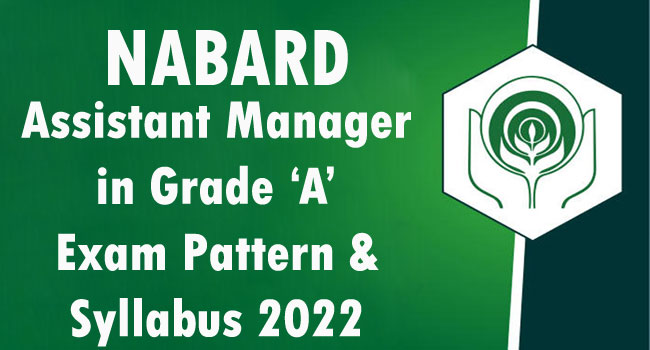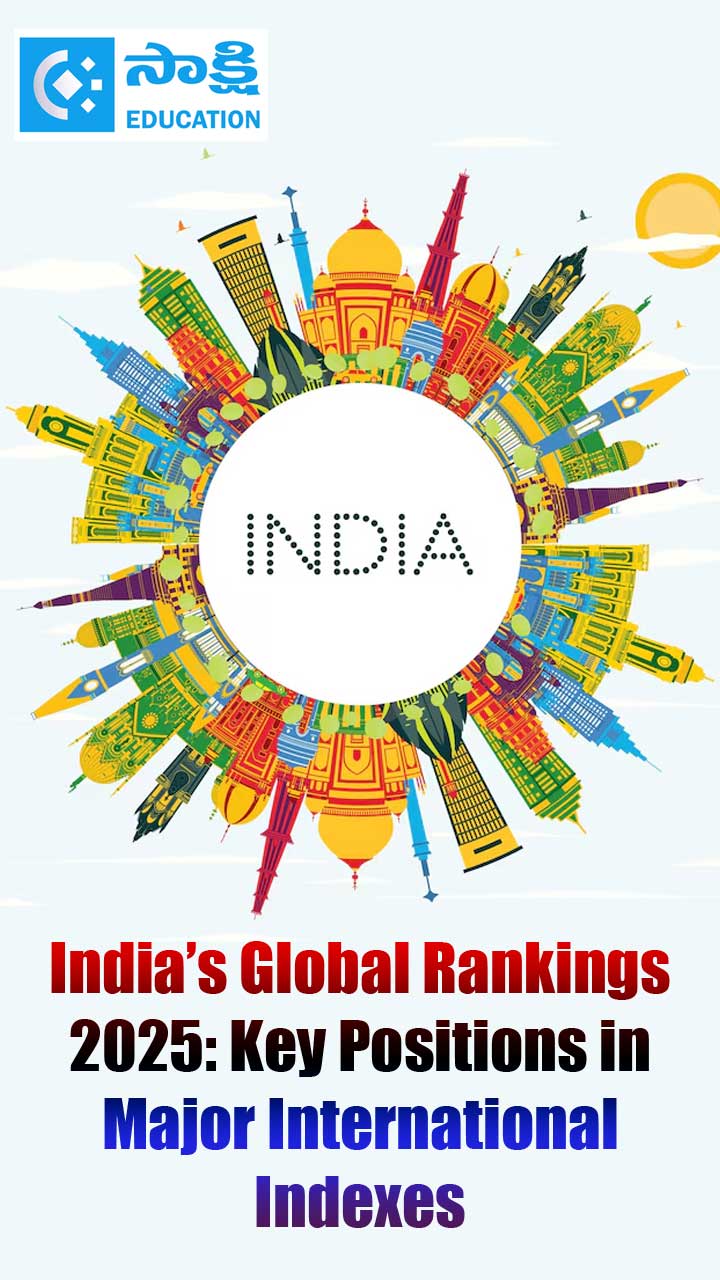NABARD Assistant Manager in Grade ‘A’ Exam Pattern & Syllabus 2022

SELECTION PROCEDURE: -The selection will be in three Phases as furnished below:
Preliminary Examination Structure for Grade A (RDBS/Rajbhasha):
|
Name of the Test |
No. of Qs. |
Max Marks |
Time |
|
Test of Reasoning |
20 |
20 |
120 Minutes |
|
English Language |
30 |
30 |
|
|
Computer Knowledge |
20 |
20 |
|
|
20 |
20 |
||
|
Decision Making |
10 |
10 |
|
|
20 |
20 |
||
|
Eco & Soc. Issues (with focus on Rural India) |
40 |
40 |
|
|
Agriculture & Rural Development with Emphasis on Rural India |
40 |
40 |
|
|
Total |
200 |
200 |
|
i) Qualifying Section - Test of Reasoning, English Language, Computer Knowledge, Quantitative Aptitude, Decision Making
ii) ii) Merit Section - General Awareness, Eco & Soc. Issues (with focus on Rural India), Agriculture & Rural Development with Emphasis on Rural India.
iii) Shortlisting of the candidates for the Main exam will be based on marks scored in the Merit section only
Mains Exam Test Structure for Grade A
Main Examination for the post of Generalist
|
Paper |
Grade A |
Type of Paper |
No. of Questions |
Marks |
Duration |
Remarks |
|
Paper I |
General English |
Online Descriptive |
3 |
100 |
90 Minutes |
Descriptive Answers to be typed using keyboard |
|
Paper II |
ESI & ARD |
Objective |
30 |
50 |
30 Minutes |
|
|
Descriptive Type |
6 questions will be asked, of which candidates will be required to attempt 4 questions [2 of 15 marks each (with difficulty level) and 2 of 10 marks each] |
50 |
90 Minutes |
Descriptive Answers to be typed using keyboard either in English or Hindi (Remington and Inscript keyboards) |
Main Examination for the post of Specialist
|
Paper |
Grade A |
Type of Paper |
No. of Questions |
Marks |
Duration |
Remarks |
|
Paper I |
General English |
Online Descriptive |
3 |
100 |
90 Minutes |
Descriptive Answers to be typed using keyboard |
|
Paper II |
Stream Specific Paper |
Objective |
30 |
50 |
30 Minutes |
|
|
Descriptive Type |
6 questions will be asked, of which candidates will be required to attempt 4 questions [2 of 15 marks each (with difficulty level) and 2 of 10 marks each] |
50 |
90 Minutes |
Descriptive Answers to be typed using keyboard either in English or Hindi (Remington and Inscript keyboards) |
NCFM and NSIM Certifications: Advantage for Graduates of Economics, Commerce, Management and Banking
Main Examination for the post of Rajbhasha
|
Paper |
Grade A |
Type of Paper |
No. of Questions |
Marks |
Duration |
Remarks |
|
Paper I |
General English |
Online Descriptive |
3 |
100 |
90 Minutes |
Descriptive Answers to be typed using keyboard |
|
Paper II |
Stream Specific Paper |
Objective |
30 |
50 |
30 Minutes |
|
|
Descriptive Type |
6 questions will be asked, of which candidates will be required to attempt 4 questions [2 of 15 marks each (with difficulty level) and 2 of 10 marks each] |
50 |
90 Minutes |
Descriptive Answers to be typed using keyboard either in English or Hindi (Remington and Inscript keyboards) |
Interview (RDBS/ Rajbhasha): 50 Marks
The calling Ratio to qualify for the main examination and interview would be a maximum of 1:25 and 1:3, respectively. The ratio may be suitably reduced at the discretion of the bank.
Candidates who qualify and rank sufficiently high as decided by NABARD, shall be called for appearing at the Main Examination and Interview. There will be penalty for wrong answers marked by the candidate. For every wrong answer marked, 1/4th of the marks assigned to that question will be deducted as penalty in Phase-I and Phase-II, both. Cut-offs in Phase-I and Phase-II may be applied in two stages: (i) On scores in individual tests, (ii) On Total Score
Since the vacancies are earmarked discipline-wise, merit list of candidates for each stage will be prepared discipline-wise.
B. Only such candidates who score the minimum cut off marks or above in the Main Examination will be shortlisted for interview. The final selection and ranking of the applicants for the post of Assistant Manager in Grade ‘A’ (RDBS/ Rajbhasha) will be based on their performance in the Phase-II Main Examination and Interview, taken together. In case of candidates securing same marks, their ranking will be decided as under:
I. Amongst the candidates having equal marks in total (Main examination + interview taken together), the candidate with higher marks in Main Examination will be ranked higher.
II. In case of having equal marks in Main Examination, candidate with higher qualification or in case of similar qualification, candidate with higher marks in graduation will be ranked higher. In case of further tie-up, the candidate senior in age will be ranked higher.
NOTE: With a view to overcoming the possibility of applicants seeking help of other applicants during the online / main exam, the Bank would be analysing the responses of applicants in the main examination with other appeared applicants to detect patterns of similarity of right and wrong answers. On the basis of such an analysis, if it is suspected that the responses have been shared and scores obtained are not genuine/ valid, the Bank reserves the right to cancel the candidature of the suspected applicants. Hence the applicants are advised in their own interest not to indulge in any unfair practice in the exams.
VI. SYLLABUS
The syllabus for all subjects is indicative and not exhaustive. The syllabus should not be considered as the only source of information while preparing for the examination. Keeping in view the nature of examination, all matters falling within the realm of the subject concerned will have to be studied by the candidate as questions can be asked on all relevant matters under the subject. Candidates appearing for the examination should also prepare themselves for answering questions that may be asked on the current/latest developments/Acts taking place under the subject(s) although those topics may not have been specifically included in the syllabus.
Illustrative syllabus for Phase II (Main Examination) may be as furnished below:
For Grade A (RDBS) (All Disciplines from (i) to (xi) in Table 1 and Grade A (Rajbhasha)
1) Paper I – English: Essay, Précis writing, Comprehension and Business/Office Correspondence. The paper on English shall be framed in a manner to assess the writing skills including expressions and understanding the topic.
For Grade A (RDBS) (General Discipline) as at (i) in Table 1
2) Paper II – Economic & Social Issues and Agriculture & Rural Development (ESI & ARD)
Economic & Social Issues: Nature of Indian Economy - Structural and Institutional features - Economic underdevelopment - Opening up the Indian Economy - Globalization - Economic Reforms in India - Privatisation. Inflation - Trends in Inflation & their Impact on National Economy and Individual Income. Poverty Alleviation and Employment Generation in India - Rural and Urban - Measurement of Poverty - Poverty Alleviation Programmes of the Government. Population Trends - Population Growth and Economic Development - Population Policy in India. Agriculture - Characteristics / Status - Technical and Institutional changes in Indian Agriculture - Agricultural performance - Issues in Food Security in India - Non Institutional and Institutional Agencies in rural credit. Industry - Industrial and Labour Policy - Industrial performance - Regional Imbalance in India's Industrial Development - Public Sector Enterprises. Rural banking and financial institutions in India - Reforms in Banking/ Financial sector. Globalization of Economy - Role of International Funding Institutions - IMF & World Bank - WTO - Regional Economic Co-operation. Social Structure in India - Multiculturalism - Demographic trends - Urbanisation and Migration – Gender Issues Joint family system - Social Infrastructure - Education - Health and Environment. Education - Status & System of Education - Socio -Economic Problems associated with Illiteracy - Educational relevance and educational wastage - Educational Policy for India. Social Justice: Problems of scheduled castes and scheduled tribes - socio-economic programmes for scheduled castes and scheduled tribes and other backward classes. Positive Discrimination in favour of the under privileged - Social Movements -Indian Political Systems- Human Development. Current Economic & Social Issues.
Agriculture & Rural Development: Agriculture: definition, meaning and its branches, Agronomy: definition, meaning and scope of agronomy. Classification of field crops. Factors affecting crop production, Agro Climatic Zones; Cropping Systems: Definition and types of cropping systems. Problems of dry lanagriculture; Seed production, seed processing, seed village; Meteorology: weather parameters,crop-weather advisory; Precision Farming, System of Crop Intensification, organic farming;
a) Soil and Water Conservation: Major soil types, soil fertility, fertilisers, soil erosion, soil conservation, watershed management;
b) Water Resource: Irrigation Management: types of irrigation, sources of irrigation, crop-water requirement, command area development, water conservation techniques, micro-irrigation, irrigation pumps, major, medium and minor irrigation.
c) Farm and Agri Engineering: Farm Machinery and Power, Sources of power on the farm- human, animal, mechanical, electrical, wind, solar and biomass, bio fuels, water harvesting structures, farm ponds, watershed management, Agro Processing, Controlled and modified storage, perishable food storage, godowns, bins and grain silos.
d) Plantation & Horticulture: Definition, meaning and its branches. Agronomic practices and production technology of various plantation and horticulture crops. Post-harvest management, value and supply chain management of Plantation and Horticulture crops.
e) Animal Husbandry: Farm animals and their role in Indian economy, Animal husbandry methods in India, common terms pertaining to different species of livestock, Utility classification of breeds of cattle. Introduction to common feeds and fodders, their classification and utility. Introduction to poultry industry in India (past, present and future status), Common terms pertaining to poultry production and management. Concept of mixed farming and its relevance to socio-economic conditions of farmers in India. Complimentary and obligatory nature of livestock and poultry production with that of agricultural farming.
f) Fisheries: Fisheries resources, management and exploitation - freshwater, brackish water and marine; Aquaculture- Inland and marine; biotechnology; post-harvest technology. Importance of fisheries in India. Common terms pertaining to fish production.
g) Forestry: Basic concepts of Forest and Forestry. Principles of silviculture, forest mensuration, forest management and forest economics. Concepts of social forestry, agro forestry, joint forest management. Forest policy and legislation in India, India State of Forest Report 2015. Recent developments under Ministry of Environment, Forest and Climate Change.
h) Agriculture Extensions: Its importance and role, methods of evaluation of extension programmes, Role of Krishi Vigyan Kendra's (KVK) in dissemination of Agricultural technologies.
i) Ecology and Climate Change: Ecology and its relevance to man, natural resources, their sustainable management and conservation. Causes of climate change, Green House Gases (GHG), major GHG emitting countries, climate analysis, distinguish between adaptation and mitigation, climate change impact to agriculture and rural livelihood, carbon credit, IPCC, UNFCCC, CoP meetings, funding mechanisms for climate change projects, initiatives by Govt of India, NAPCC, SAPCC, INDC.
j) Present Scenario of Indian Agriculture and Allied activities; recent trends, major challenges in agriculture measures to enhance viability of agriculture. Factors of Production in agriculture; Agricultural Finance and Marketing; Impact of Globalization on Indian Agriculture and issues of Food Security; Concept and Types of Farm Management.
Rural Development: Concept of Rural Area, Structure of the Indian Rural Economy Importance and role of the rural sector in India- Economic, Social and Demographic Characteristics of the Indian rural economy, causes of Rural Backwardness.
Rural population in India; Occupational structure, Farmers, Agricultural Labourers, Artisans, Handicrafts, Traders, Forest dwellers/tribes and others in rural India- Trends of change in rural population and rural work force; problems and conditions of rural labour; Issues and challenges in Handlooms
Panchayati Raj Institutions – Functions and Working. MGNREGA, NRLM – Aajeevika, Rural Drinking water Programmes, Swachh Bharat, Rural Housing, PURA and other rural development programmes.
Note: The illustrative syllabus for Main Examination - Paper II for Grade A (RDBS)- Specialised Disciplines at Sr. No. (ii) to (xii) in Table-I and Grade A (Rajbhasha) will be uploaded on website.
NABARD Recruitment 2022 Assistant Manager Grade A - Last Date: August 07, 2022



















